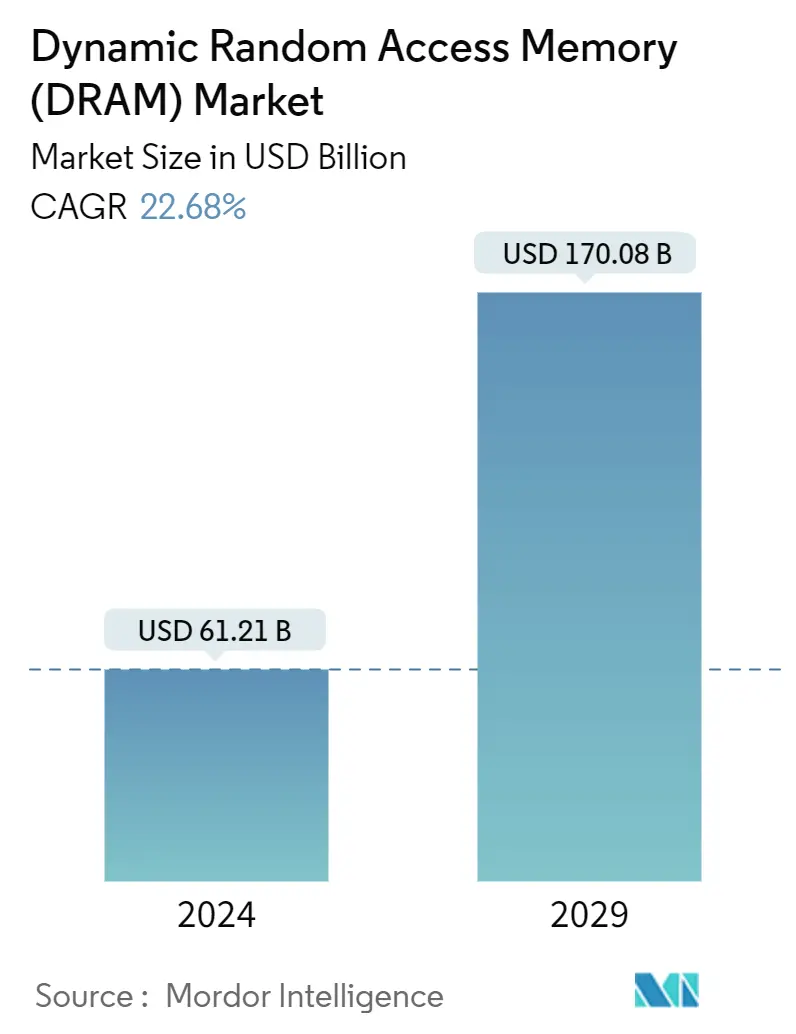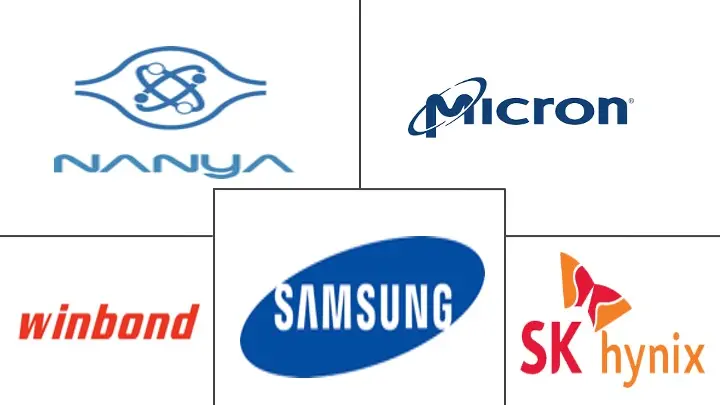Market Size of Dynamic Random Access Memory (DRAM) Industry

| Study Period | 2019 - 2029 |
| Market Size (2024) | USD 61.21 Billion |
| Market Size (2029) | USD 170.08 Billion |
| CAGR (2024 - 2029) | 22.68 % |
| Fastest Growing Market | North America |
| Largest Market | North America |
Major Players
*Disclaimer: Major Players sorted in no particular order |
Need a report that reflects how COVID-19 has impacted this market and its growth?
Dynamic Random Access Memory (DRAM) Market Analysis
The Dynamic Random Access Memory Market size is estimated at USD 61.21 billion in 2024, and is expected to reach USD 170.08 billion by 2029, growing at a CAGR of 22.68% during the forecast period (2024-2029).
Semiconductor memory, commonly referred to as dynamic random access memory (DRAM), is utilized to store and process data or program code necessary for a computer processor's functioning. This type of RAM is commonly found in personal computers, smartphones, ADAS systems, smartwatches, workstations, and servers.
- The growing adoption of generative AI boosts the demand for fast processing and highly efficient DRAM solutions. For instance, Micron Technology partnered with Qualcomm Technologies Inc. to accelerate generative AI at the edge for smartphones. The company shipped production samples of the low-power double data rate 5X (LPDDR5X) memory to Qualcomm in October 2023. The LPDDR5X memory operates at a world-leading 9.6 Gbps speed grade, delivering the speed and performance the mobile ecosystem needs to unleash the power of AI at the edge.
- Micron LPDDR5X provides advanced power-saving capabilities for mobile users using its innovative, 1β process node technology. Also, in September 2023, SK Hynix announced and presented a prototype of their AI accelerator card, AiMX1, based on the high-speed, low-power, and high-density memory solution GDDR6-AiM at the AI hardware & edge AI Summit 2023 in California. AiMX1 is expected to significantly contribute to developing high-performance, data-intensive, and AI-based systems.
- Datacenter demand for DRAM is projected to grow significantly, which will lift overall DRAM demand annually. Artificial intelligence and other cutting-edge technologies like streaming, gaming, and autonomous vehicles will continue to drive robust demand for data centers. This will drive innovation in data center architecture and technology as operators strive to provide the capacity that supports the increased power density required by high-performance computing. Integrating artificial intelligence, the Internet of Things, and 5G will be a massive tailwind to the demand for computing and DRAM.
- Worldwide smartphone shipments declined significantly in FY 2023 compared to FY 2022 due to decreased consumer spending, economic downturn, and increased inflation. The leading smartphone vendors such as Samsung, Apple, Xiaomi, and Oppo (including One Plus) witnessed a decline in the sales of smartphones. Following smartphones, tablets, and PCs/laptops, demand declined in FY 2023 due to weakened consumer spending, interest rates, and increasing uncertainty due to ongoing geopolitical tensions. These factors will restrict the growth of the DRAM market.
- The COVID-19 pandemic had a significant impact on the DRAM market, both on the demand side and the supply side. Lockdowns and factory shutdowns worldwide contributed to the supply shortage, but many of these impacts are expected to be temporary. Governments worldwide are taking steps to support the semiconductor industries, which could lead to a recovery.
